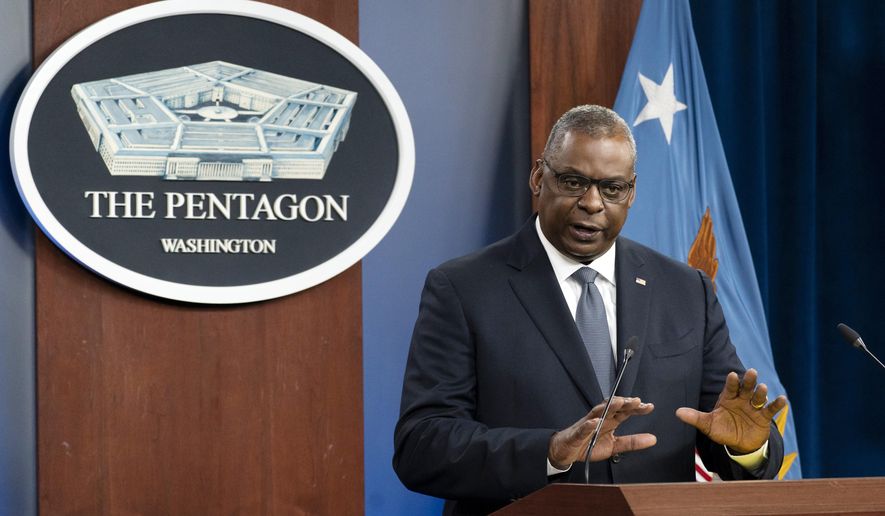A “whiff.” A “word salad.” “Sticking our heads in the sand.”
The Pentagon’s much-touted Global Posture Review is racking up some pretty brutal reviews of its own.
Critics across the spectrum say the strategic blueprint ordered up by President Biden and outlined by Pentagon officials Monday falls far short of its own self-described mission: to reorient the U.S. military to face what Defense Secretary Lloyd Austin calls the “pacing threat” posed by a rising China in the Indo-Pacific region.
Nine months of study, internal debate and analysis resulted in a review that largely embraced the status quo for U.S. deployments around the world, aside from “operational-level adjustments we have already announced and a couple of other challenges that are still being developed,” as one senior Defense Department official explained to reporters in a background call.
No major shift of troops from Europe, the Middle East or Africa was announced. In the “priority theater” of Asia itself, the only significant apparent recommendations — the review as a whole is not being made public — included sending new fighter and bomber aircraft to Australia, establishing a new permanent squadron of attack helicopters in South Korea, and seeking new money to beef up existing U.S. military facilities in Guam, Australia and the Northern Mariana Islands.
The GPR talks of upgrading U.S. military alliances in the region and seeking new bases, but any major new initiatives will “manifest [themselves] over the next two or three years or so,” the Defense Department briefer said.
Critics have pounced on what they say is a lack of specifics, a lack of hard choices and a lack of clear guidance in what was supposed to be a policy blueprint for the Pentagon. Some say the document reflects a Pentagon still internally torn over whether to move troops and resources from still-problematic theaters such as Eastern Europe and the Middle East to confront China.
The GPR ” appears to be almost a year’s worth of make-work,” one unnamed congressional staffer told the website Foreign Policy.com. “No decisions, no changes, no sense of urgency, no creative thinking. Lots of word salad.”
Emma Ashford, resident senior fellow at the Atlantic Council’s Scowcroft Center for Strategy and Security, shared on Twitter a scathing critique she offered to Politico after the outlines of the GPR were announced: “There’s nothing strategic — or even useful — about a [GPR] that fails to accept the notion of resource complaints and declines to face any hard choices about America’s place in the world,” she wrote.
If the modest changes are all that come from the report, “then this review amounts to little more than sticking our heads in the sand and pretending that it’s still 1992,” she added.
Critics on the left and the right Tuesday came together on one point: The new GPR may not be good, but it wasn’t as bad as it could have been.
Tom Spoehr, director of the conservative Heritage Foundation’s Center for National Defense, said in an analysis Tuesday that the Biden Pentagon blueprint at least avoided stripping U.S. deployments elsewhere in the planned pivot to Asia.
“Given the potential that the Biden administration could have recommended drastic reductions in theaters such as Europe, the Middle East and Africa, this review could be considered validation of the status quo and from that perspective, reflects good news.”
But Mr. Spoehr said the review did nothing to address the fundamental problem that the “U.S. military is under-resourced for great-power competition” with China.
And Benjamin H. Friedman, policy director for the liberal Defense Priorities, said the GPR arrived with a “whimper,” but its lack of specifics and failure to recommend a more aggressive basing strategy in Asia were blessings by default.
“U.S. force posture is a servant of a wasteful strategy that sees U.S. garrisons as magical solutions to problems they don’t solve, and that U.S. foreign policy could safely ignore in most cases,” Mr. Friedman wrote. “… More U.S. forces and basing near China are not going to slow Beijing’s rise as a great power and are unnecessary to defend major allies there, who are rich and defensible.”
Past administration GPRs, he added, “typically gush strategic-sounding piffle, exhausting readers with laborious defenses of the status quo. This one at least spared us that.”
Even Pentagon officials appeared to be aware of the modesty of the final product’s public portions, even while insisting the document provides “a much more robust understanding of the baseline” and of the challenge China poses, in the words of Mara Karlin, assistant secretary of defense for strategy, plans and capabilities.
“I think on the Indo-Pacific, this is kind of moving the needle a bit, and over the years we’re going to move the needle more and more,” Mr. Karlin said.
• David R. Sands can be reached at dsands@washingtontimes.com.




Please read our comment policy before commenting.